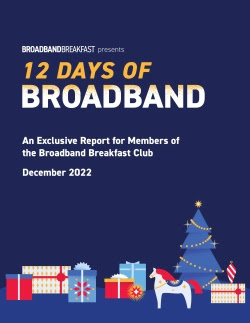State Broadband Offices Face Major Challenges With Limited Resources
State officials are responsible for the disbursal of federal broadband infrastructure funds, but many offices are understaffed.
David B. McGarry

State broadband officials must administer funding programs, build broadband availability maps, promote digital equity, coordinate with federal agencies, and much more. They have consistently argued that engaging robust staking engagement and diverse partnerships is indispensable to their success.
Although the bulk of the broadband industry’s scrutiny is now directed federal government, the source of what many experts call a “once-in-a-generation” investment in broadband infrastructure, once those grants are issued to the states, state officials must plan and oversee the final disbursal of those funds.
The 12 Days of Broadband 2022 (click to open)
- On the First Day of Broadband, my true love sent to me:
A Symmetrical Gigabit Network - On the Second Day of Broadband, my true love sent to me:
24 Reverse-Preemption Pole Attachment States (2022 edition) - On the Third Day of Broadband, my true love sent to me:
Section Two-30 of the Communications Decency Act - On the Fourth Day of Broadband, my true love sent to me:
$42.5 billion in Broadband Equity, Access and Deployment funds - On the Fifth Day of Broadband, my true love sent to me:
5 Federal Communications Commissioners - On the Sixth Day of Broadband, my true love sent to me:
Wi-Fi 6E - On the Seventh Day of Broadband, my true love sent to me:
7.7% annual inflation rate - On the Eighth Day of Broadband, my true love sent to me:
8,132,968 census blocks and a national Broadband Fabric - On the Ninth Day of Broadband, my true love sent to me:
$9 Billion Universal Service Fund - On the Tenth Day of Broadband, my true love sent to me:
$10 Billion Remaining in the Affordable Connectivity Program - On the Eleventh Day of Broadband, my true love sent to me:
11th Year of Xi Jinping’s rule in China - On the Twelfth Day of Broadband, my true love sent to me:
12 or More State Broadband Officers
Many states’ broadband offices are young, understaffed, and under-resourced. In a conversation with Broadband Breakfast, Ramon S. Hobdey-Sanchez, the broadband program manager at the Idaho Department of Commerce, explained that his small office faces myriad challenges, both geographic (extensive mountains and rivers) and technical (limited middle-mile infrastructure).
Hobdey-Sanchez said his office seeks to educate Idaho communities. With representatives from the National Telecommunications and Information Administration, the state recently hosted a local-coordination conference attended by hundreds of Idahoans, he said, adding that his constituents are concerned about navigating the complexities of grant writing and local permitting regimes.

At October’s AnchorNets 2022 conference, Louisiana’s broadband director, Veneeth Iyengar, said extensive and recurring local feedback has illuminated his office’s “blindspots.”
Glen Howie, broadband director of Arkansas and an alumnus of Louisiana’s broadband office, has said that he, too, encourages ground-up leadership from local officials. “It’s not really about Washington, and it’s not even really about Little Rock, it’s about” local communities, Howie told the audience at Broadband Breakfast’s Digital Infrastructure Investment conference in November.
At Digital Infrastructure Investment, Kenrick Gordon, Maryland’s broadband director, said that his state prioritizes the funding applications of community-backed providers.
A spokesperson for the Pennsylvania Department of Community and Economic Development told Broadband Breakfast that the Keystone State has partnered with Penn State Extension assess the accuracy of the FCC’s mapping data and facilitate a forthcoming bulk challenge. The spokesperson emphasized the importance of public participation in the challenge process as well.
Illinois broadband officials have in part credited the successes of the state’s mapping initiative to specialized local knowledge provided by community leaders. Maine Connectivity Authority President Andrew Butcher told Broadband Breakfast that he will rally communities and other stakeholders to correct the Federal Communications Commission’s newly released national broadband map.
Kansas broadband director, Jade Piros de Carvalho, said her office lacks the resources to submit a fabric challenge, but asked Kansans to submit individual challenges.
Hobdey-Sanchez said he hopes to submit a bulk challenge to the FCC’s map by mid-January. Idaho will soon build a state broadband map, he said, and is likely to announce the award of the mapping contract by the end of December.
There is no shortage of state-mapping models, and existing maps often clash with the FCC’s datasets. Georgia and North Carolina, for instance, which used a fabric-based and a speed-test model, respectively, suggest that Washington has severely overestimated service coverage, according to a report published earlier this year.
In October, Piros de Carvalho and Joshua Breitbart, senior vice president of New York State’s ConnectALL program, told the 2022 INCOMPAS Show that input from private industry helps state officials structure funding programs to be more attractive to private dollars. Kansas “encourage[s] new entrants into markets that have been ignored or are only being served by satellite or DSL,” the Kansas director said.
States must also bolster the broadband workforce, which many experts say is too small and inexperienced. “What we’re focused on in Ohio is building out career pathways so that individuals can understand what the different paths there are for them to move up in the industry,” said Eric Leach, deputy director of Ohio Governor’s Office of Workforce Transformation, at a November Broadband Breakfast Live Online event discussing a state partnership with Ohio State University. “It’s really about creating a career ladder,” he added.










Member discussion